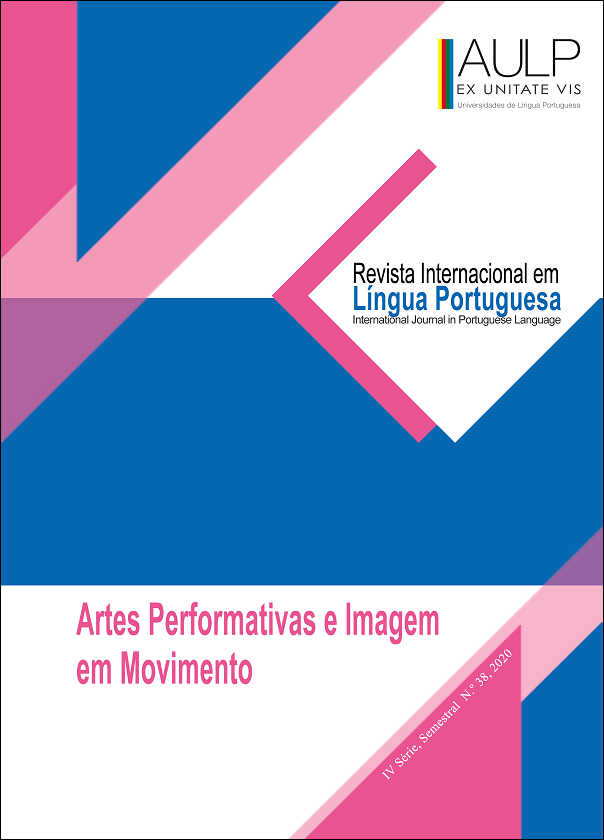A força da gravidade e a origem do movimento
##plugins.themes.bootstrap3.article.main##
Keywords
alentejano; força da gravidade; resistência e entrega; superfície de suporte; meio circundante; centro do corpo.
Resumo
No centro da ação performativa, vamos encontrar a relação que o corpo estabelece com a força da gravidade. A resistência ou entrega a esta força, a exploração do seu poder sobre o movimento e a presença da ilusão gravitacional noutras produções artísticas multidisciplinares, justificam este estudo. Aprofundam-se os momentos em que o corpo se ergue, movimenta ou é capaz de se orientar, precisamente, quando se opõe à força da gravidade, quando negoceia com esta ou quando se proprioceciona. Na variedade de superfícies de suporte – às qual o corpo se apoia, agarra, pendura, salta e desliza – encontra-se um potencial criativo que resulta da relação de resistência à força da gravidade que o corpo estabelece, num determinado momento, com estas mesmas superfícies. Apresentam-se, também, meios circundantes que transformam, de forma radical, o movimento e sua relação com a gravidade. Por fim, retorna-se ao corpo, ao centro do corpo, para aí encontrar o impulso primordial do movimento.
Referências
Bailey, E. (2012). Mari Mori and Pipilotti Rist: Reflections on the “new levity” in arts. In M. Edwards & E. Bailey (Eds.), Gravity in arts: Essays on weight and weightlessness in painting, sculpture and photography (pp. 338-341). Jefferson: MacFarland & Company, Inc., Publishers.
Banes, S. (1987). Terpsichore in sneakers: Post-modern dance. Wesleyan: Wesleyan University Press.
Copeland, R. (2004). Merce Cunningham: The modernizing of modern dance. New York: Routledge.
Crespo, F. (1988). A justification for the inclusion of the strands of the dance medium in dance analysis. Master of Arts in Dance Studies – thesis. Laban Centre for Movement and Dance, London.
Daly, A. (1995). Done into dance: Isadora Duncan in America. Bloomington: Indiana University Press.
Delaumosne, L’Abbé (1893). Delaumosne on Delsatre. In Delsarte system of oratory (pp. xiii- 170). New York: Edgar S. Werner.
Dempster, E. (2010). Women writing the body: let’s watch a little how she dances. In A. Carter and J. O’Shea (Eds.), The Routledge dance studies reader (pp. 229-235). Oxon: Routledge.
Duncan, I. (1928). Ma vie. Paris: Librairie Gallimard.
Dzenko, C. (2012). Photographic moments inside of gravity: Kerry Skarbkka’s struggle to right himself. In M. Edwards & E. Bailey (Eds.), Gravity in arts: Essays on weight and weightlessness in painting, sculpture and photography (pp. 326-337). Jefferson: MacFarland & Company, Inc., Publishers.
Feldenkrais, M. (1987). Awareness through movement: Health exercises for personal growth. Harmondsworth: Penguin Books Ltd.
Foster, S. (2011). Choreographing Empathy. London: Routledge. iBooks.
Graham, M. (1991). Blood Memory. New York: Doubleday.
Hardt, Y. and Sander, V. (2014). Understanding the body/movement. In I. Diehl, F. Lampert (Eds.), Dance techniques 2012: Tanzplan Germany (pp. 250-255). Leipzig: Henschel Verlag in der Seemann Henschel GmbH & Co. KG.
Hutchison, A. (1977). Labanotation or Kinetography Laban: The system of analyzing and recording movement. New York: Theatre Arts Books.
Jowitt, D. (2010). In pursuit of the sylph: ballet in the Romantic period. In A. Carter and J. O’Shea (Eds.), The Routledge dance studies reader (pp.209-219). Oxon: Routledge.
Juhan, D. (1998). Job’s Body. New York: Station Hill.
Kaltenbrunner, T. (2004). Contact improvisation: Moving - dancing – interaction. Oxford: Meyer und Meyer
Kleist, H. (2009). Sobre o teatro das marionetas e outros escritos. Lisboa: Antígona.
Kolodziej, M. (2012). From vertigo to ethereality in environmental art. In M. Edwards &. Bailey(Eds.), Gravity in arts: Essays on weight and weightlessness in painting, sculpture and photography (pp. 293-303). Jefferson: MacFarland & Company, Inc., Publishers.
LaMothe, K. (2006). Nietzsche’s Dancers: Isadora Duncan, Martha Graham, and the revaluation of Christian values. New York: Palgrave MacMilan.
Laws, K. (2002). Physics and the art of dance: Understanding movement. Oxford: Oxford University Press.
Maletic, V. (1987). Body-space-expression: The development of Rudolf Laban’s movement and dance concepts. Berlin: Mouton de Gruyter.
Novack, C. (1990). Sharing the Dance: Contact Improvisation and American Culture. Madison: University of Wisconsin Press.
Siegmund, G. & van Dijk, A. (2014). Introduction: The difficulty of running. In I. Diehl & F. Lampert (Eds.), Dance techniques 2010: Tanzplan Germany (pp. 66-69). Leipzig: Henschel Verlag in der Seemann Henschel GmbH & Co. KG.
Sparshott, F. (1995). A measured pace: Towards a philosophical understanding of the arts of the dance. Toronto: University of Toronto Press.
Stebbins, G. (1887). Delsarte system of expression. New York: Edgar S. Werner.
Straus, W. (1966). The upright posture. In M. Natson (Ed.), Essays in Phenomenology (pp. 169-192). Dordrecht: Springer, Science, Business Media, B.V.
Streader, T. & Williams, A. (1985). Create your own stage lighting. London: Bell and Hyman Limited.
Toepfer, K. (1997). Empire of ecstasy: Nudity and movement in German body culture, 1910-1935. University of California Press.
Tözeren, A. (2000). Human body dynamics: Classical mechanics and human movement.New York: Springer-Verlag.
Vitrubius, M. (1826). The architecture of Marcus Vitrubius Pollio in ten books. Joseph Gwilt (Trad.). London: Priestly and Weale.
Weaver, J. (1721). Anatomical and mechanical: Lectures upon dancing. London: J. Brotherton and W. Meadows.
Zollig, G. ( 2010). Searching for that “other land of dance”: The phases in developing a choreography. In B. Bläsing, M. Puttke and T. Schack (Eds.), The neurocognition of dance: Mind, movement and motor skills (pp. 115-122). Hove: Psychology Press.

